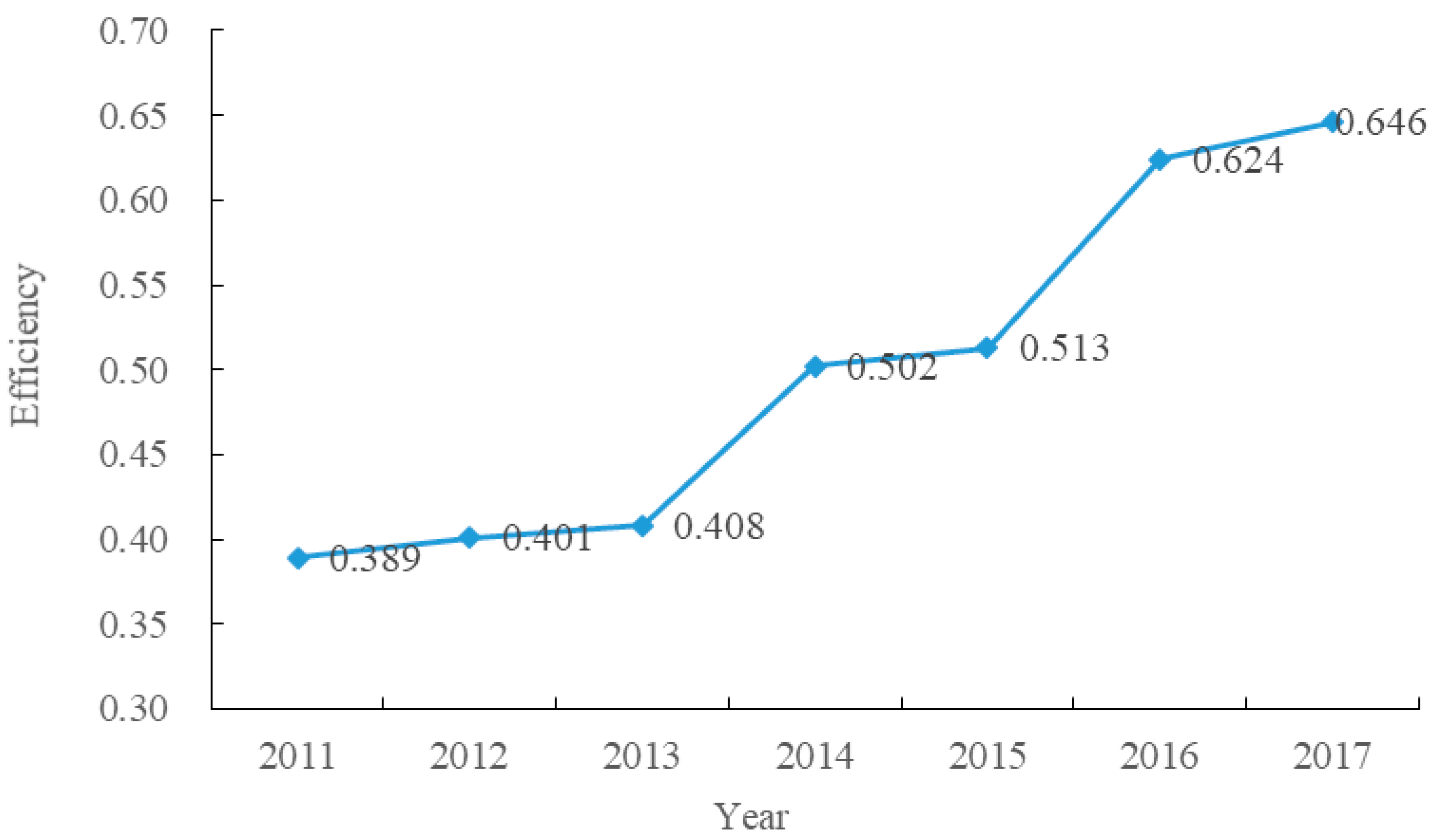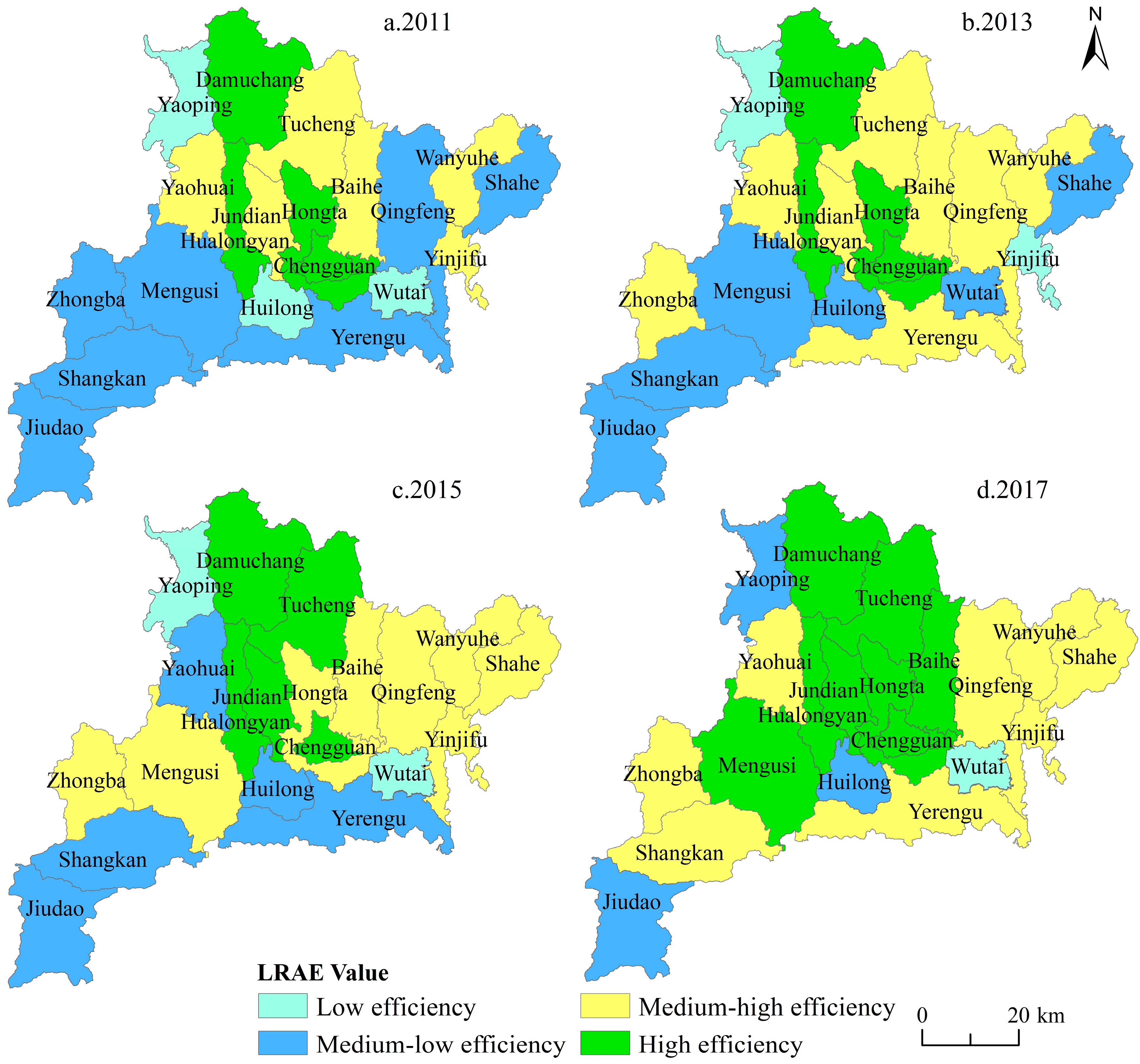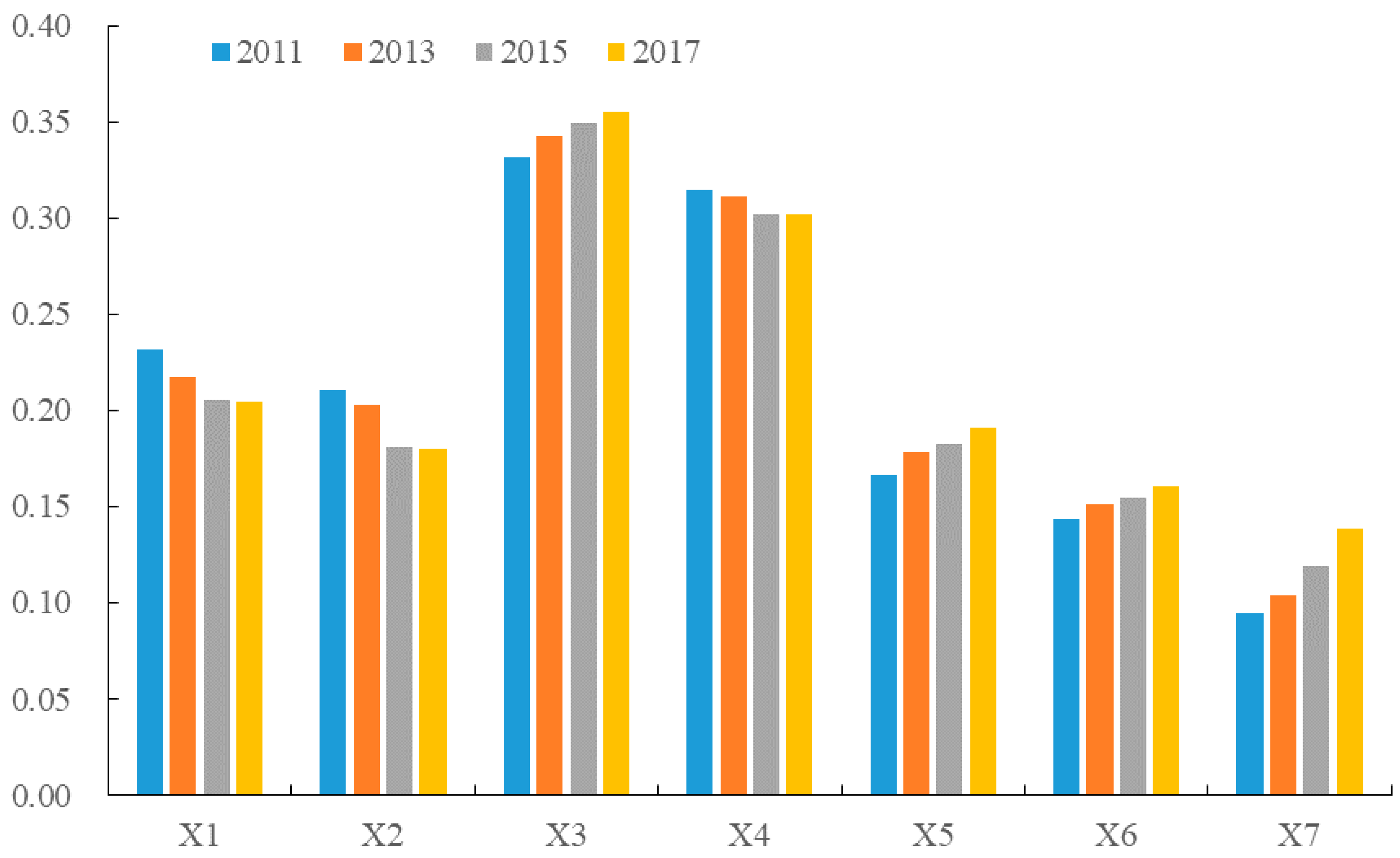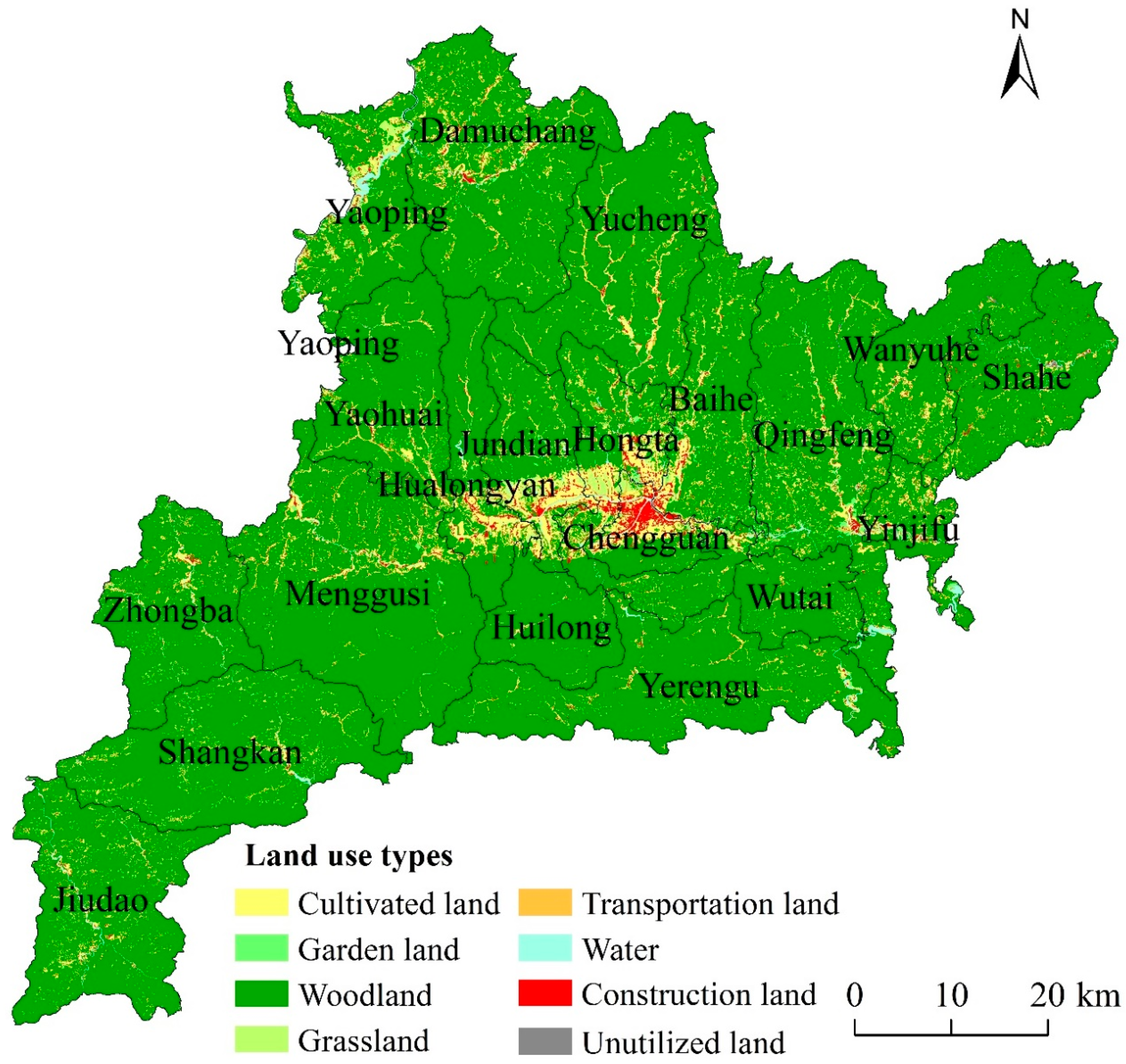Allocation Efficiency, Influencing Factors and Optimization Path of Rural Land Resources: A Case Study in Fang County of Hubei Province, China
Abstract
1. Introduction
2. Study Area
3. Methodology and Data Sources
3.1. Variable Selection and Data Description
3.2. SBM-Undesirable Model
3.3. Geodetector Model
3.4. Data Sources
4. Results and Discussion
4.1. Dynamic Measurement and Analysis of Rural LRAE
4.1.1. Analysis of Rural LRAE at the County Scale
4.1.2. Analysis of Rural LRAE at Township Scale
4.1.3. Analysis of Rural LRAE at Village Scale
4.2. Analysis of Influencing Factors on Rural LRAE
4.3. Optimal Path of Rural Land Resources Allocation
5. Conclusions and Policy Implications
5.1. Summary
5.2. Policy Implications
Author Contributions
Funding
Conflicts of Interest
References
- Tang, L.; Wang, D. Optimization of county-level land resource allocation through the improvement of allocation efficiency from the perspective of sustainable development. Int. J. Environ. Res. Public Health 2018, 15, 2638. [Google Scholar] [CrossRef]
- Bazame, R.; Tanrivermis, H.; Kapusuz, Y.E. Land management and sustainable use of land resources in the case of Burkina Faso. Land Degrad. Dev. 2019, 30, 608–621. [Google Scholar] [CrossRef]
- Smith, S.J.; Rothwell, A. Carbon density and anthropogenic land-use influences on net land-use change emissions. Biogeosciences 2013, 10, 6323–6337. [Google Scholar] [CrossRef]
- Yang, B.; Chen, X.; Wang, Z.; Li, W.; Zhang, C.; Yao, X. Analyzing land use structure efficiency with carbon emissions: A case study in the Middle Reaches of the Yangtze River, China. J. Clean. Prod. 2020, 123076. [Google Scholar] [CrossRef]
- Prøsch-Danielsen, L.; Prescott, C.; Fredh, E. Land cover and exploitation of upland resources on the Høg-Jæren Plateau, southwestern Norway, over the last 6500 years. J. Archaeol. Sci. Rep. 2020, 32, 102443. [Google Scholar]
- Liu, Y.; Fang, F.; Li, Y. Key issues of land use in China and implications for policy making. Land Use Policy 2014, 40, 6–12. [Google Scholar] [CrossRef]
- Wang, Z.; Chen, J.; Zheng, W.; Deng, X. Dynamics of land use efficiency with ecological intercorrelation in regional development. Landsc. Urban Plan. 2018, 177, 303–316. [Google Scholar] [CrossRef]
- Deng, X.; Huang, J.; Rozelle, S.; Zhang, J.; Li, Z. Impact of urbanization on cultivated land changes in China. Land Use Policy 2015, 45, 1–7. [Google Scholar] [CrossRef]
- Yu, J.; Zhou, K.; Yang, S. Land use efficiency and influencing factors of urban agglomerations in China. Land Use Policy 2019, 88, 104143. [Google Scholar] [CrossRef]
- Liu, Y. Introduction to land use and rural sustainability in China. Land Use Policy 2018, 74, 1–4. [Google Scholar] [CrossRef]
- Liu, J.; Jin, X.; Xu, W.; Gu, Z.; Yang, X.; Ren, J.; Fan, Y.; Zhou, Y. A new framework of land use efficiency for the coordination among food, economy and ecology in regional development. Sci. Total Environ. 2020, 710, 135670. [Google Scholar] [CrossRef] [PubMed]
- Guastella, G.; Pareglio, S.; Sckokai, P. A spatial econometric analysis of land use efficiency in large and small municipalities. Land Use Policy 2017, 63, 288–297. [Google Scholar] [CrossRef]
- Liu, Y.; Zhang, Z.; Zhou, Y. Efficiency of construction land allocation in China: An econometric analysis of panel data. Land Use Policy 2018, 74, 261–272. [Google Scholar] [CrossRef]
- Sfez, S.; De Meester, S.; Vlaeminck, S.; Dewulf, J. Improving the resource footprint evaluation of products recovered from wastewater: A discussion on appropriate allocation in the context of circular economy. Resour. Conserv. Recycl. 2019, 148, 132–144. [Google Scholar] [CrossRef]
- Zheng, W.; Ke, X.; Xiao, B.; Zhou, T. Optimising land use allocation to balance ecosystem services and economic benefits: A case study in Wuhan, China. J. Environ. Manag. 2019, 248, 109306. [Google Scholar] [CrossRef]
- Wise, M.; Dooley, J.; Luckow, P.; Calvin, K.; Kyle, P. Agriculture, land use, energy and carbon emission impacts of global biofuel mandates to mid-century. Appl. Energy 2014, 114, 763–773. [Google Scholar] [CrossRef]
- Han, H.; Zhang, X. Static and dynamic cultivated land use efficiency in China: A minimum distance to strong efficient frontier approach. J. Clean. Prod. 2020, 246, 119002. [Google Scholar] [CrossRef]
- Yadav, D.; Wang, J. Modelling carbon dioxide emissions from agricultural soils in Canada. Environ. Pollut. 2017, 230, 1040–1049. [Google Scholar] [CrossRef]
- Maia, R.; Silva, C.; Costa, E. Eco-efficiency assessment in the agricultural sector: The Monte Novo irrigation perimeter, Portugal. J. Clean. Prod. 2016, 138, 217–228. [Google Scholar] [CrossRef]
- Czyżewski, B.; Smędzik-Ambroży, K.; Mrówczyńska-Kamińska, A. Impact of environmental policy on eco-efficiency in country districts in Poland: How does the decreasing return to scale change perspectives? Environ. Impact Assess. Rev. 2020, 84, 106431. [Google Scholar] [CrossRef]
- Awad, O.; Ma, X.; Kamil, M.; Ali, O.; Ma, Y.; Shuai, S. Overview of polyoxymethylene dimethyl ether additive as an eco-friendly fuel for an internal combustion engine: Current application and environmental impacts. Sci. Total Environ. 2020, 715, 136849. [Google Scholar] [CrossRef] [PubMed]
- Kariminejad, N.; Hosseinalizadeh, M.; Pourghasemi, H.R.; Bernatek-Jakiel, A.; Campetella, G.; Ownegh, M. Evaluation of factors affecting gully headcut location using summary statistics and the maximum entropy model: Golestan Province, NE Iran. Sci. Total Environ. 2019, 677, 281–298. [Google Scholar] [CrossRef] [PubMed]
- Yuan, C.; Liu, S.; Wu, J. Research on energy-saving effect of technological progress based on Cobb-Douglas production function. Energy Policy 2009, 37, 2842–2846. [Google Scholar] [CrossRef]
- Duan, C.; Chen, B. Analysis of global energy consumption inequality by using Lorenz curve. Energy Procedia 2018, 152, 750–755. [Google Scholar] [CrossRef]
- Uberti, M.; Antunes, M.; Debiasi, P.; Tassinari, W. Mass appraisal of farmland using classical econometrics and spatial modeling. Land Use Policy 2018, 72, 161–170. [Google Scholar] [CrossRef]
- Mueller, M.; Fueser, H.; Höss, S.; Traunspurger, W. Species-specific effects of long-term microplastic exposure on the population growth of nematodes, with a focus on microplastic ingestion. Ecol. Indic. 2020, 118, 106698. [Google Scholar] [CrossRef]
- Prokop, P. Tea plantations as a driving force of long-term land use and population changes in the Eastern Himalayan piedmont. Land Use Policy 2018, 77, 51–62. [Google Scholar] [CrossRef]
- Liu, Y.; Li, J.; Yang, Y. Strategic adjustment of land use policy under the economic transformation. Land Use Policy 2018, 74, 5–14. [Google Scholar] [CrossRef]
- Nel, E.; Connelly, S. Regional economic transformation: Changing land and resource access on the West Coast of New Zealand’s South Island. Land Use Policy 2020, 93, 103947. [Google Scholar] [CrossRef]
- Mahdiloo, M.; Saen, R.; Lee, K. Technical, environmental and eco-efficiency measurement for supplier selection: An extension and application of data envelopment analysis. Int. J. Prod. Econ. 2015, 168, 279–289. [Google Scholar] [CrossRef]
- Li, H.; Zhao, Y.; Zheng, F. The framework of an agricultural land-use decision support system based on ecological environmental constraints. Sci. Total Environ. 2020, 717, 137149. [Google Scholar] [CrossRef] [PubMed]
- Xu, L.; Tan, J. Financial development, industrial structure and natural resource utilization efficiency in China. Resour. Policy 2020, 66, 101642. [Google Scholar] [CrossRef]
- He, Y.; Liao, N.; Rao, J.; Fu, F.; Chen, Z. The optimization of investment strategy for resource utilization and energy conservation in iron mines based on Monte Carlo and intelligent computation. J. Clean. Prod. 2019, 232, 672–691. [Google Scholar] [CrossRef]
- Fu, Y.; Shi, X.; He, J.; Yuan, Y.; Qu, L. Identification and optimization strategy of county ecological security pattern: A case study in the Loess Plateau, China. Ecol. Indic. 2020, 112, 106030. [Google Scholar] [CrossRef]
- Wang, G.; Han, Q. Assessment of the relation between land use and carbon emission in Eindhoven, the Netherlands. J. Environ. Manag. 2019, 247, 413–424. [Google Scholar] [CrossRef]
- Tiwari, S.; Daryanto, Y.; Wee, H. Sustainable inventory management with deteriorating and imperfect quality items considering carbon emission. J. Clean. Prod. 2018, 192, 281–292. [Google Scholar] [CrossRef]
- Zhu, S.; Kong, X.; Jiang, P. Identification of the human-land relationship involved in the urbanization of rural settlements in Wuhan city circle, China. J. Rural Stud. 2020, 77, 75–83. [Google Scholar] [CrossRef]
- Kuang, B.; Lu, X.; Han, J.; Fan, X.; Zuo, J. How urbanization influence urban land consumption intensity: Evidence from China. Habitat Int. 2020, 100, 102103. [Google Scholar] [CrossRef]
- Xu, F.; Wang, Z.; Chi, G.; Zhang, Z. The impacts of population and agglomeration development on land use intensity: New evidence behind urbanization in China. Land Use Policy 2020, 95, 104639. [Google Scholar] [CrossRef]
- Hao, Y.; Wang, L.O.; Zhu, L.; Ye, M. The dynamic relationship between energy consumption, investment and economic growth in China’s rural area: New evidence based on provincial panel data. Energy 2018, 154, 374–382. [Google Scholar] [CrossRef]
- Ye, C.; Ma, X.; Cai, Y.; Gao, F. The countryside under multiple high-tension lines: A perspective on the rural construction of Heping Village, Shanghai. J. Rural Stud. 2018, 62, 53–61. [Google Scholar] [CrossRef]
- Wang, Y.; Pan, J. Building ecological security patterns based on ecosystem services value reconstruction in an arid inland basin: A case study in Ganzhou District, NW China. J. Clean. Prod. 2019, 241, 118337. [Google Scholar] [CrossRef]
- Li, S.; Zhang, H.; Zhou, X.; Yu, H.; Li, W. Enhancing protected areas for biodiversity and ecosystem services in the Qinghai-Tibet Plateau. Ecosyst. Serv. 2020, 43, 101090. [Google Scholar] [CrossRef]
- Zhao, Z.-Y.; Gao, L.; Zuo, J. How national policies facilitate low carbon city development: A China study. J. Clean. Prod. 2019, 234, 743–754. [Google Scholar] [CrossRef]
- Chen, W.; Li, J. Who are the low-carbon activists? Analysis of the influence mechanism and group characteristics of low-carbon behavior in Tianjin, China. Sci. Total Environ. 2019, 683, 729–736. [Google Scholar] [CrossRef] [PubMed]
- Zhu, E.; Deng, J.; Zhou, M.; Gan, M.; Jiang, R.; Wang, K.; Shahtahmassebi, A. Carbon emissions induced by land-use and land-cover change from 1970 to 2010 in Zhejiang, China. Sci. Total Environ. 2019, 646, 930–939. [Google Scholar] [CrossRef]
- Xie, G.; Lu, C.; Leng, Y.; Zheng, D.; Li, S. Ecological assets valuation of the Tibetan Plateau. J. Nat. Resour. 2003, 18, 189–196. [Google Scholar]
- Tone, K. A slacks-based measure of efficiency in data envelopment analysis. Eur. J. Oper. Res. 2001, 130, 498–509. [Google Scholar] [CrossRef]
- Tone, K. Variations on the theme of slacks-based measure of efficiency in DEA. Eur. J. Oper. Res. 2010, 200, 901–907. [Google Scholar] [CrossRef]
- Wang, J.; Xu, C. Geodetector: Principle and prospective. Acta Geogr. Sin. 2017, 72, 116–134. [Google Scholar]
- Zhao, R.; Zhan, L.; Yao, M.; Yang, L. A geographically weighted regression model augmented by Geodetector analysis and principal component analysis for the spatial distribution of PM 2.5. Sustain. Cities Soc. 2020, 56, 102106. [Google Scholar] [CrossRef]
- Zhu, L.; Meng, J.; Zhu, L. Applying Geodetector to disentangle the contributions of natural and anthropogenic factors to NDVI variations in the middle reaches of the Heihe River Basin. Ecol. Indic. 2020, 117, 106545. [Google Scholar] [CrossRef]
- Han, J.; Huang, Y.; Zhang, H.; Wu, X. Characterization of elevation and land cover dependent trends of NDVI variations in the Hexi region, Northwest China. J. Environ. Manag. 2019, 232, 1037–1048. [Google Scholar] [CrossRef]
- Yang, B.; Wang, Z.; Yao, X.; Chai, J. Assessing the performance of land consolidation projects in different modes: A case study in Jianghan Plain of Hubei Province, China. Int. J. Environ. Res. Public Health 2020, 17, 16. [Google Scholar] [CrossRef] [PubMed]
- Yang, Y.; Wang, K. The effects of different land use patterns on the microclimate and ecosystem services in the agro-pastoral ecotone of Northern China. Ecol. Indic. 2019, 106, 105522. [Google Scholar] [CrossRef]
- Ge, D.; Long, H.; Qiao, W.; Wang, Z.; Sun, D.; Yang, R. Effects of rural-urban migration on agricultural transformation: A case of Yucheng City, China. J. Rural Stud. 2020, 76, 85–95. [Google Scholar] [CrossRef]
- Xu, D.; Guo, S.; Xie, F.; Liu, S.; Cao, S. The impact of rural laborer migration and household structure on household land use arrangements in mountainous areas of Sichuan Province, China. Habitat Int. 2017, 70, 72–80. [Google Scholar] [CrossRef]
- Yang, B.; Wang, Z.; Yao, X.; Zhang, L. Terrain gradient effect and spatial structure characteristics of land use in mountain areas of northwestern Hubei Province. Resour. Environ. Yangtze Basin 2019, 28, 313–321. [Google Scholar]
- Chen, W.; Ye, X.; Li, J.; Fan, X.; Liu, Q.; Dong, W. Analyzing requisition-compensation balance of farmland policy in China through telecoupling: A case study in the middle reaches of Yangtze River Urban Agglomerations. Land Use Policy 2019, 83, 134–146. [Google Scholar] [CrossRef]
- Qu, Y.; Jiang, G.; Li, Z.; Tian, Y.; Wei, S. Understanding rural land use transition and regional consolidation implications in China. Land Use Policy 2019, 82, 742–753. [Google Scholar] [CrossRef]
- Yin, X.; Chen, J.; Li, J. Rural innovation system: Revitalize the countryside for a sustainable development. J. Rural Stud. 2019. [Google Scholar] [CrossRef]
- Zhou, Y.; Li, X.; Liu, Y. Rural land system reforms in China: History, issues, measures and prospects. Land Use Policy 2020, 91, 104330. [Google Scholar] [CrossRef]
- Gao, J.; Liu, Y.; Chen, J. China’s initiatives towards rural land system reform. Land Use Policy 2020, 94, 104567. [Google Scholar] [CrossRef]
- Su, B.; Li, Y.; Li, L.; Wang, Y. How does nonfarm employment stability influence farmers’ farmland transfer decisions? Implications for China’s land use policy. Land Use Policy 2018, 74, 66–72. [Google Scholar] [CrossRef]
- Wang, B.; Li, F.; Feng, S.; Shen, T. Transfer of development rights, farmland preservation, and economic growth: A case study of Chongqing’s land quotas trading program. Land Use Policy 2020, 95, 104611. [Google Scholar] [CrossRef]






| Criterion Layer | Indicator Layer | Indicator Description |
|---|---|---|
| Input variables | Land | Cultivated land (I1) |
| Garden land (I2) | ||
| Woodland (I3) | ||
| Grassland (I4) | ||
| Transportation land (I5) | ||
| Water areas (I6) | ||
| Construction land (I7) | ||
| Unutilized land (I8) | ||
| Labor | Population engaged in the primary industries (I9) | |
| Capital | Fixed capital investment in rural areas (I10) | |
| Output variables | Economic benefits | Total GDP of rural areas (O1) |
| Social benefits | Annual income of rural resident (O2) | |
| Ecological benefits | Ecosystem services values (O3) | |
| Undesirable output | Total carbon emissions (O4) |
| Influencing Factors | Variables | References |
|---|---|---|
| Physical geographic conditions | Slope (X1) | Liu et al. (2020) [11] |
| Elevation (X2) | Han et al. (2019) [53] | |
| Rural development conditions | Proportion of primary industry (X3) | Liu et al. (2018) [10] |
| Rural population (X4) | Yang et al. (2020) [54] | |
| Engel coefficient (X5) | Yang et al. (2019) [55] | |
| Urban-rural relationship | Urbanization rate (X6) | Ge et al. (2020) [56] |
| Gap between urban-rural per capita income (X7) | Ge et al. (2020) [56] |
| Township | Input (Redundancy) | Output (Optimization) | ||||||||||
|---|---|---|---|---|---|---|---|---|---|---|---|---|
| I1 | I2 | I3 | I4 | I5 | I6 | I7 | I8 | O1 | O2 | O3 | O4 | |
| Baihe | 15.21 | 31.45 | 31.92 | 27.81 | 8.23 | 20.49 | 8.63 | 28.29 | 14.32 | 2.58 | 18.15 | 3.45 |
| Chengguan | 4.60 | 26.90 | −21.35 | 14.46 | 3.48 | 15.20 | 7.69 | 13.45 | 28.66 | 1.08 | 29.17 | 8.65 |
| Damuchang | 12.54 | 45.70 | 46.27 | 23.67 | 9.05 | 33.14 | 15.09 | 23.25 | 17.93 | 4.49 | 16.10 | 3.24 |
| Hongta | 6.34 | 23.26 | −12.65 | 51.69 | 11.49 | 21.34 | 10.51 | 17.41 | 17.39 | 1.12 | 24.62 | 6.21 |
| Hualongyan | 5.54 | 35.42 | 34.87 | 32.97 | 7.42 | 36.01 | 18.72 | 11.42 | 13.40 | 5.76 | 19.47 | 2.36 |
| Huilong | 6.78 | 27.53 | 54.09 | 36.72 | 2.12 | 17.24 | 10.17 | 13.46 | 8.12 | 0.87 | 8.76 | 0.87 |
| Jiudao | 9.42 | 38.44 | 15.49 | 25.36 | 2.30 | 26.75 | 15.10 | 27.26 | 7.62 | 0.65 | 9.73 | 0.65 |
| Jundian | 8.46 | 47.52 | 18.92 | 28.96 | 13.70 | 18.76 | 11.23 | 19.77 | 14.07 | 4.31 | 16.95 | 5.25 |
| Mengusi | 1.58 | 58.71 | 14.33 | 26.99 | 9.76 | 22.03 | 15.78 | 20.92 | 18.72 | 1.33 | 35.47 | 4.32 |
| Qingfeng | 11.96 | 40.84 | 23.87 | 26.04 | 11.19 | 35.29 | 17.60 | 22.34 | 19.02 | 2.13 | 32.16 | 2.86 |
| Shahe | 8.76 | 35.89 | 34.74 | 43.05 | 16.72 | 39.58 | 20.01 | 29.90 | 14.44 | 2.15 | 23.16 | 3.78 |
| Shangkan | 6.75 | 50.12 | 43.20 | 40.71 | 8.41 | 24.53 | 7.69 | 19.14 | 4.66 | 0.36 | 12.45 | 4.91 |
| Tucheng | 9.47 | 34.09 | 23.54 | 38.92 | 16.87 | 22.13 | 8.28 | 18.36 | 9.68 | 1.67 | 15.99 | 4.31 |
| Wanyuhe | 8.87 | 43.06 | 26.94 | 43.16 | 4.24 | 32.12 | 9.90 | 17.11 | 11.90 | 2.81 | 23.84 | 1.24 |
| Wutai | 7.36 | 50.43 | 34.99 | 34.29 | 5.68 | 9.12 | 6.66 | 10.83 | 16.32 | 0.46 | 16.13 | 0.35 |
| Yaoping | 10.01 | 27.13 | 32.87 | 38.15 | 3.55 | 11.33 | 6.78 | 27.08 | 7.78 | 0.91 | 9.00 | 2.34 |
| Yaohuai | 10.07 | 49.72 | 31.28 | 27.41 | 4.20 | 24.87 | 7.79 | 20.81 | 10.84 | 1.56 | 7.28 | 1.85 |
| Yerengu | 12.81 | 49.64 | 35.15 | 54.76 | 4.47 | 23.88 | 8.28 | 20.47 | 20.21 | 3.56 | 28.47 | 3.00 |
| Yinjifu | 9.48 | 84.14 | 45.61 | 44.32 | 5.40 | 21.72 | 13.12 | 17.02 | 8.76 | 2.14 | 18.75 | 5.31 |
| Zhongba | 3.34 | 36.42 | 17.78 | 57.90 | 6.53 | 30.08 | 11.24 | 15.98 | 6.71 | 5.92 | 25.40 | 3.69 |
| Total | 8.47 | 41.82 | 26.59 | 35.87 | 7.74 | 24.28 | 11.51 | 19.71 | 13.53 | 2.29 | 19.55 | 3.43 |
© 2020 by the authors. Licensee MDPI, Basel, Switzerland. This article is an open access article distributed under the terms and conditions of the Creative Commons Attribution (CC BY) license (http://creativecommons.org/licenses/by/4.0/).
Share and Cite
Yang, B.; Wang, Z.; Zhang, B.; Zhang, D. Allocation Efficiency, Influencing Factors and Optimization Path of Rural Land Resources: A Case Study in Fang County of Hubei Province, China. Int. J. Environ. Res. Public Health 2020, 17, 5898. https://doi.org/10.3390/ijerph17165898
Yang B, Wang Z, Zhang B, Zhang D. Allocation Efficiency, Influencing Factors and Optimization Path of Rural Land Resources: A Case Study in Fang County of Hubei Province, China. International Journal of Environmental Research and Public Health. 2020; 17(16):5898. https://doi.org/10.3390/ijerph17165898
Chicago/Turabian StyleYang, Bin, Zhanqi Wang, Bo Zhang, and Di Zhang. 2020. "Allocation Efficiency, Influencing Factors and Optimization Path of Rural Land Resources: A Case Study in Fang County of Hubei Province, China" International Journal of Environmental Research and Public Health 17, no. 16: 5898. https://doi.org/10.3390/ijerph17165898
APA StyleYang, B., Wang, Z., Zhang, B., & Zhang, D. (2020). Allocation Efficiency, Influencing Factors and Optimization Path of Rural Land Resources: A Case Study in Fang County of Hubei Province, China. International Journal of Environmental Research and Public Health, 17(16), 5898. https://doi.org/10.3390/ijerph17165898





